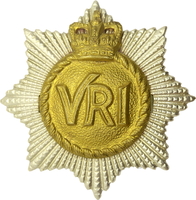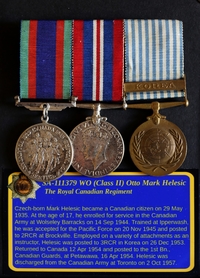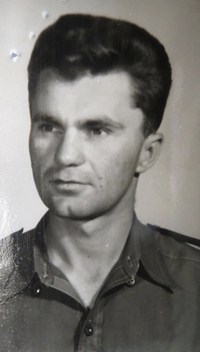
SA-111379 Warrant Officer (Class II) Otto Mark Helesic
The Royal Canadian Regiment
By: Capt (ret'd) Michael M. O'Leary, CD, The RCR
Otto Mark Helesic was born on 4 Feb 1927 at Pilsen, Czechoslovakia. His family emigrated to Canada and Helesic became a Canadian citizen on 29 May 1935. The Helesic family was living at Goderich, Ontario, before and during the Second World War. By the fall of 1944, when Otto enlisted in the Canadian Army (Active Force) (Regulars), he was a welder employed at Richards-Wilcox Ltd., in London, Ontario.
At the age of 17, Otto Helesic enrolled for service in the Canadian Army at District Depot No. 1, Wolseley Barracks, London, on 14 September 1944. He was living at 359 King Street in London at the time. Otto identified his mother as next-of-kin, she was living on Brittania Road in Goderich, Ontario. Although Helesic's attestation paper does not provide a physical description, his discharge document a few years later describes him as five feet seven inches in height with a fair complexion, brown eyes, and brown hair. A notation on Helesic's enrolment form no doubt alludes to his national origin, stating "Anywhere including Overseas except most secret assignments."
Helesic's training started on 6 Oct 1944 when he was taken on strength of the Canadian Infantry (Basic) Training Centre, No. 12, at Chatham, Ontario. On completion of basic training he proceeded on 2 Dec 1944 to join the A-29 Canadian Infantry Corps Training centre at Camp Ipperwash. Here he qualified for his "Mars Badge," denoting a trained soldier, on 14 Mar 1945. Remaining at Ipperwash while waiting an assignment or to move forward into the reinforcement system, on 30 May 1945 Otto Helesic volunteered for the Pacific Force. He was accepted for the Pacific Force on 20 Nov 1945 and posted to the 2nd Battalion, The Royal Canadian Regiment, stationed at Brockville. This battalion was initially formed as the 1st Canadian Infantry Battalion, 1st Brigade, of Canada's intended Pacific Force. The infantry units of the Division were latterly given regimental titles and affiliations, most matching the units of the 1st Canadian Division. When the Canadian Army returned from Europe and the overseas battalion of the Regiment was demobilized, the "2nd Battalion" in Brockville became "The RCR."
By early 1946, Helesic would complete the Platoon Weapons Course at the Royal Canadian School of Infantry (RCS of I) at Camp Borden. On 29 Jan 1946 he would be appointed Acting Sergeant, from Acting Corporal, and on 7 Feb the same year was confirmed in the substantive rank of Corporal.
Helesic was discharged from the Canadian Army (Active) at London, Ontario, on 30 Sep 1946. For his service he was awarded the Canadian Volunteer Service Medal and the War Medal 1939-1945.
Simultaneous with his discharge from the wartime military forces of Canada, Corporal Otto Helesic enrolled in the Regular Army at Brockville, Ontario, on 1 Oct 1946. Engaging for a period of service of three years and taken on strength as a Corporal, Helesic would draw a monthly pay of $70 and was granted recognition of one year, one month, and 23 days service in the rank of Corporal.
Shortly after joining the unit, Helesic qualified as a "Driver "i/c" Class II (Tracked)" on 1 Dec 1946. On 21 May 1947 he was attached to the RCS of I, Camp Borden. On 3 May 1948, this attachment ceased and he was instead be attached to the Royal 22e Regiment at Valcartier. This attachment would last until Sep 1948, during which Helesic would be promoted to the rank of Sergeant on 13 Jul 1948.
Returning to the RCS of I at Borden on 17 Sep 1948, he would find himself back on course and complete the 3" Mortar course on 12 Dec 1948 and draw the pay of an Infantry Instructor (Mortar) Group I, effective from 1 November, and pay for the Group II level of qualification starting 15 Mar 1949.
On 21 Apr 1949, Helesic would be attached to the Princess Patricia's Canadian Light Infantry (PPCLI) at Calgary, Alberta, returning to Borden on 6 Sep 1949. In April 1950, he had a small brush with the military judicial system and was reprimanded for being 4 days AWL, also forfeiting four days pay. From 23 Apr until 9 Sep 1950, Helesic was again on temporary duty, this time at Valcartier for the Quebec Command Summer Training Camp.
Back at Borden and the School for the fall, in December 1950, Helesic was qualified on the Carrier Tactical and Flame Instructor's Course. His new qualification must have made him an in-demand instructor, within the first months of 1951 he was employed at Esquimalt with the Royal Canadian School of Artillery, at Calgary with Lord Strathcona's Horse, at Shilo, and at Petawawa with 1RCR. Back in Borden by 13 March, Helesic gained qualifications for the 81mm Mortar Instructor's Course (27 Jul 1951) and the 17-Pounder Anti-Tank Instructors' Course (22 Dec 1951). Effective 22 Dec 1951, Helesic was also confirmed as qualified under CAT Specifications as an Instructor Battalion (Group III). This came with a bonus of 3 years increase in pay of Sergeant (Instr Inf (Mortar)).
Otto Helesic would remain with the School of Infantry until he was transferred to the Canadian Army Liaison Establishment at London, England, beginning 30 Oct 1952. On 8 Nov 1952 he was attached to the Guards Training Battalion at Pirbright, England. On 4 Jan 1953 he transferred to the Guards Depot at Caterham for ten days followed by a further move to Wellington Barracks, London. On 5 Feb 1953 Helesic moved again, joining the 2nd Battalion, Scots Guards, at Windsor, followed by the 2nd Battalion, Coldstream Guards serving in the British Army on the Rhine on 12 Feb. On 28 Feb, Helesic finally returned to the School of Infantry at Camp Borden.
Helesic was promoted to the substantive rank of Staff Sergeant on 23 Jun 1953. On 28 Aug 1953 he married Miss Irene Colman at Camp Borden. Changes of address in Helesic's file would trace the moves that Irene made through Otto's career. A few months after the wedding, The path of Helesic's service was to take another change of direction. On 16 Oct 1953 Helesic was taken on strength of No. 11 Personnel Depot at Vancouver. Only nine days later, he boarded ship to sail across the Pacific. On 26 Oct 1953 he was placed on the X-4 List, a holding list for unposted reinforcements, and posted to the Canadian Army (Far East). Otto Helesic disembarked in Japan on 9 Nov 1953.
In steady stages, Helesic moved towards the front lines of Canada's peacekeeping force in Korea. On 11 Nov he was transferred to No. 25 Canadian Reinforcement Group, on 10 Dec he landed in Korea and was passed to the Headquarters 25 Canadian Infantry Brigade, and finally, on 26 Dec 1953 he was posted to the 3rd Battalion, The Royal Canadian Regiment, in Korea. Helesic would only be entitled to the UN medal for his service in Korea. Arriving in the theatre of war as a reinforcement after the Armistice on 27 Jul 1953, he would not also be eligible for the Canadian Korea Medal.
The Ottawa Journal of 25 Mar 1954, in an article on 3RCR's closing days in Korea, offers a brief mention of Helesic's service in Korea: "The battalion Drill Instructor is S/Sgt. Mark Helesic, 27, of Goderich, Ont. He won his post after placing first in a JNCOs drill course at the world's toughest drill school, the Brigade of Guards in England. His last big job was preparing a composite brigade honor guard and retreat ceremony for the visit of Prime Minister St. Laurent." The Prime Minister's visit to the Canadian Force in Korea commenced on 8 Mar 1954.
Otto Helesic ceased drawing his foreign service allowance on 26 Mar 1954, the date he was struck off strength for return to Canada. Landing in Canada on 12 Apr 1954, he was posted to the 1st Battalion, Canadian Guards at Petawawa effective 16 Apr 1954. Returning to further attachments and employment as an instructor, Helesic was promoted to Acting Warrant Officer (Class II) on 10 Aug 1954. Employed between his parent unit and the School of Infantry as a Company Sergeant Major (WO II), Helesic also added new qualifications. On 2 Mar 1956 he was qualified as an Infantry Machine Gunner (Gp I) and on 29 Mar 1957 he became and Advanced Infantry Pioneer.
Otto Mark Helesic was transferred from the 1st Battalion, Canadian Guards, to No. 6 Personnel Depot, Toronto, on 11 Jun 1957. Following a period of leave, he was discharged from the Canadian Army at Toronto on 2 Oct 1957.
Pro Patria
Visit a randomly selected page in The O'Leary Collection (or reload for another choice):
- The O'Leary Collection; Medals of The Royal Canadian Regiment.
- Researching Canadian Soldiers of the First World War
- Researching The Royal Canadian Regiment
- The RCR in the First World War
- Badges of The RCR
- The Senior Subaltern
- The Minute Book (blog)
- Rogue Papers
- Tactical Primers
- The Regimental Library
- Battle Honours
- Perpetuation of the CEF
- A Miscellany
- Quotes
- The Frontenac Times
- Site Map
QUICK LINKS
The O'Leary Collection—Medals of The Royal Canadian Regiment
Newest additions:
![]()
![]() SB-12725 Private Henry "Hank" Ard
SB-12725 Private Henry "Hank" Ard ![]()
WIA at Hill 187, Died of Wounds in Japan
![]()
![]() 2355331 Lance Corporal Albert Lorking
2355331 Lance Corporal Albert Lorking
Wounded in action, later a War Amps representative.
![]()
![]() 4334 / 477996 Pte Isaac Hamilton Wilcox
4334 / 477996 Pte Isaac Hamilton Wilcox
Permanent Force, South Africa, and C.E.F.
![]()
![]() 477019 Private Harold Ashcroft
477019 Private Harold Ashcroft
Transferred to the Tunnelers.
![]()
![]() 734231 Private Clark D. Thompson
734231 Private Clark D. Thompson ![]()
The older Thompson brother, killed in action.
![]()
![]() 733849 Private Norman Parker Thompson
733849 Private Norman Parker Thompson
The younger Thompson brother; post-war service in the Special Guard.
![]()
![]()
![]() A305 / 400305 Private Andrew Walker
A305 / 400305 Private Andrew Walker ![]()
"Previously reported Wounded, now Killed in Action."
![]()
![]() 823298 Pte Thomas Patrick Steele, M.M.
823298 Pte Thomas Patrick Steele, M.M. ![]()
… for gallant conduct in the field …
![]()
![]() P13066 Sergeant Harold Thompson
P13066 Sergeant Harold Thompson
Instrumental Soloist for over 20 years of Canadian Army service.
![]()
![]() 9609 / 477728 Private Albert Edward Piper
9609 / 477728 Private Albert Edward Piper
"Arrived from England as a STOWAWAY …"




